
1
SKY-POD INSTRUCTIONS
Installation varies depending upon which vehicle you have. Find your vehicle’s section below.
If you purchased the unit WITH speakers, you may need some additional wire for your particular application. Any
audio store can provide you with additional lengths of wire.
The thread-making screws (the ones with the tiny slots at the tips) are for the ‘03-’06 Wranglers.
Jeep CJ’s: Your Sky-Pod attaches to the windshield frame by using the existing screw holes for the footman loop on
your Jeep. Remove the footman loop (usually attached with torx screws) with a T-20 bit and attach the Sky-Pod with the screws
and washers provided by us. Do so by holding the pod in place and start the screws (with washers on) by reaching through the
speaker holes. You want the screws fastened tightly, no doubt, but don’t go too crazy because you don’t want to strip the
windshield’s threaded holes. Some people choose to quickly fabricate and additional strap out of a piece of metal and attach it to
the top of the pod and drill out a small hole at the top of the windshield for added security. The Sky-Pod is made of thick
plastic, though, and the two screws and washers are sufficient.
RUNNING THE WIRES: This is probably the most difficult part of the installation and there are several ways in which to do
it. No matter which way you choose, you’ll want to lower the windshield and have the wires end up at the wiper motor and pass
through the hole for the motor’s wires to end up behind the dash. Also, you’ll want to seal the extra space around the wires
where they go through the grommet hole on the Sky-Pod. Do so with a glue gun or wax, etc. to ensure the enclosure is
sealed and to avoid any ‘whistling’ noise that may occur if it’s not sealed. Here are a few ways to run the wires:
1) The windshield’s hollow. You could get really tricky and drill out a hole in the windshield beneath the Sky-Pod so the wires
pop out and go right in the bottom of the pod. You’d need to fish the wires internally down to the wiper motor, drill an exit
hole near the motor and then feed the wires through the hole for the wiper motor wires and then down behind the dash or to
your amplifier. This is a tough way to do it and isn’t recommended.
2) You can attach the adhesive-back wire clips to the metal windshield frame and run the wires over to the driver’s plastic piece
for the soft top bars. Unscrew the plastic piece, run the wires behind it, pop them out the bottom and run them through the
hole for the wiper motor wires and then down behind the dash or to your amplifier. (Probably the best way to do it.)
3) You can attach the adhesive-back wire clips to the metal windshield frame and run the wires around the frame and down
through the hole for the wiper motor wires and then down behind the dash or to your amplifier. This is the easiest way.
No matter which way you run the wires, they should
go through the hole for the wiper motor wires to get them under the dash.
‘87-’02 Wranglers: Your Sky-Pod attaches to the windshield frame by using the existing screw holes for the
footman loop on your Jeep. Remove the footman loop (usually attached with torx screws) with a T-20 bit and attach the Sky-Pod with
the screws and washers provided by us. Do so by holding the pod in place and start the screws (with washers on) by reaching through
the speaker holes. You want the screws fastened tightly, no doubt, but don’t go too crazy because you don’t want to strip the
windshield’s threaded holes. Some people choose to quickly fabricate and additional strap out of a piece of metal and attach it to the top
of the pod and drill out a small hole at the top of the windshield for added security. The Sky-Pod is made of thick plastic, though, and
the two screws and washers are sufficient.
RUNNING THE WIRES: This is probably the most difficult part of the installation and there are several ways in which to do
it. No matter which way you choose, you’ll want to seal the extra space around the wires where they go through the
grommet hole of the pod with a glue gun or wax, etc. to ensure the enclosure is sealed and to avoid any ‘whistling’ noise
that may occur if it’s not sealed. Here are a few ways to run the wires:
Run the speaker wires through here.

2
1) The windshield’s hollow. You could get really tricky and drill out a hole in the windshield beneath the Sky-Pod so the wires
pop out and go right in the bottom of the pod. You would need to fish them down internally to the wiper motor, drill an exit
hole near the motor and then feed the wires through the hole for the wiper motor wires and then down behind the dash or to
your amplifier. Of course, you’d have to remove the side roll cage bars from the windshield to do so. This is a difficult way
and is not recommended.
2) (BEST WAY) You can attach the adhesive-back wire clips to the metal windshield frame and run the wires over to your roll
bar, then run them inside the padding and down to the floor, under the carpet and up to your amplifier or radio.
3) If you’re really handy, you may be able to use a shim of some kind and push the wires under your windshield gasket, though
it may take some time and be fairly frustrating.
‘03-’06 Wranglers: Your Sky-Pod attaches to the windshield frame by removing the center plastic piece
of the Head Impact Plastic and removing the updated footman loop. First, you’ll want to remove the center plastic piece:
You’ll have to remove this first
It is held on by metal ‘pop’ clips and easily removes by moving the visors off to the sides, releasing the vehicle’s top clamps and
pulling on the plastic piece at one side and slowly working your way over to the other side For a really tidy appearance, you can
actually cut the Head Impact Plastic piece so it fits around the Sky-Pod. When doing so, you only lose one clip, so it will still
stay in place when re-installed.
When cutting you will lose this clip only
After your cut, the piece will look something like this.
It can then be re-installed before installing the Sky-Pod for a real factory look. You’ll push on the edge trim piece that’s included with
your pod to hide your cut. Some accurate measurements will ensure a tidy appearance and/or cut out the template below and use it as
a guide for cutting the hole out. This is the recommended installation method regarding the Head Impact Plastic piece.
TOP – towards foot man loop
BOTTOM – towards glass
Cut this along the dotted line and center on plastic piece. It will roll
right over the top and stop at the edge. Mark it and cut out the
plasticwith snips, roto-zip tool, etc. just take your time. It doesn’t have
to be a perfect cut because the push-on rubber edge trim will hide it and
make a nice factory appearance.

3
You still have to remove the footman loop:
CAUTION!!! When drilling out the rivets for the footman loop, be careful not to continue drilling after breaking
through the rivets. Otherwise, you may drill through the front of the windshield frame and put a hole through the frame.
Be sure to hold drill steady and firm to keep drill from bouncing out of the rivet(s) and possible damaging the vehicle.
Select Increments is not responsible for any damages done to your vehicle.
You must drill out the rivets holding it in place (use a 5/32” bit) and then use the thread-making screws (these are the screw
with the little slots at the tips) included in the hardware pack to make fresh threads.
The rivets must be drilled out near perfectly; if you are a little off-center, you’ll probably have to step up a few bit sizes to
completely remove the rivet. If this happens, you can always use larger screws to affix the pod than the ones included. You can
go to a ¼” 20 screw that’s about 7/8” long, new larger washers, and use a ¼” 20 Tap to thread the now larger holes. The
screws, washer and tap are easily acquired at your local hardware store for very little cost. Call us if you have questions.
You’ll have to drill out the rivets to remove the footman loop with a 5/32” bit.
After drilling out the rivets, carefully start running the screws in nice and straight (perpendicular to the flat surface of the
windshield) to thread the rivet holes. If you can’t get them started, you may have to step up to an 11/64 bit. Once you’ve
screwed them in about half-way, remove them and you’re ready to install the Sky-Pod. To install the Sky-Pod, hold it in place
and start the screws (with the fender washers on them first) by reaching through the speaker holes. You want the screws
fastened tightly, no doubt, but don’t go too crazy because you don’t want to strip the windshield’s threaded holes. Some people
choose to quickly fabricate and additional strap out of a piece of metal and attach it to the top of the pod and drill out a small
hole at the top of the windshield for added security. The Sky-Pod is made of thick plastic, though, and the two screws and
washers are sufficient.
RUNNING THE WIRES: The ‘03-’06 models are much easier for this task then the earlier models because you can easily
hide the wires behind the plastic windshield trim pieces. The best way is to run the wires from your amplifier or radio up under
the roll bar padding and behind the Head Impact Plastic that encases the windshield. This will ensure that the wires are
completely hidden until they pop out beneath the base of the Sky-Pod where you run them through the grommet hole and into
the pod. You can use the adhesive wire clips that are included to help keep the wire in place as it tracks across the windshield to
your roll bar. You’ll want to seal the extra space around the wires where they go through the grommet hole of the pod
with a glue gun or wax, etc. to ensure the enclosure is sealed and to avoid any ‘whistling’ noise that may occur if it’s not
sealed.
Footman Loop re-use (all years) For CJ’s and Wranglers up to 2002, you can either attach the footman loop to the
windshield or the Sky-Pod. If you want to attach it to the windshield, you can drill out two holes with a 5/32” bit below the pod
on the underside of the windshield and use the thread-making screws that are included to thread the holes. Then use the
remaining two screws not used to attach the pod or your original footman screws to fasten the loop in place. This is the
recommended way to retain use of the footman loop. The other method is to use the smaller pointed black screws (included) and
fasten the loop to the rear top of the pod as shown.
For 2003-06 Wranglers, your choices are the same as above except
that you will use your factory footman loop. If you choose to mount
it to the pod, you’ll want the screws placed as far back and close to
the actual windshield as possible. The closer the loop screws are to
the mounting screws of the pod, the better your results will be.
-
 1
1
-
 2
2
-
 3
3
-
 4
4
Select Increments 53179K Installation guide
- Type
- Installation guide
- This manual is also suitable for
Ask a question and I''ll find the answer in the document
Finding information in a document is now easier with AI
Related papers
Other documents
-
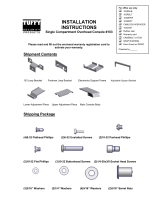 Tuffy 103-01 Installation guide
Tuffy 103-01 Installation guide
-
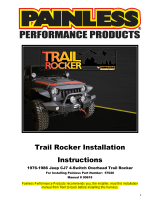 Painless Wiring 57020 Installation guide
Painless Wiring 57020 Installation guide
-
 Rugged Ridge Double Tube Rear Bumper Installation guide
Rugged Ridge Double Tube Rear Bumper Installation guide
-
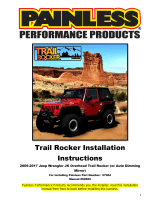 Painless Wiring Trail Rocker Relay Center Accessory Control Installation guide
Painless Wiring Trail Rocker Relay Center Accessory Control Installation guide
-
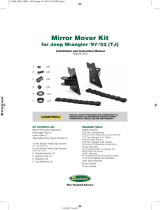 Quadratec Mirror Relocation Bracket Kit Installation guide
Quadratec Mirror Relocation Bracket Kit Installation guide
-
 MasterTop Wind Stopper Plus & Tonneau Cover 2-Piece Kit Installation guide
MasterTop Wind Stopper Plus & Tonneau Cover 2-Piece Kit Installation guide
-
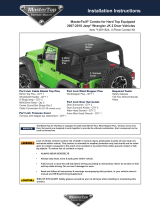 MasterTop Ultimate Summer Combo Tops in MasterTwill® Fabric Installation guide
MasterTop Ultimate Summer Combo Tops in MasterTwill® Fabric Installation guide
-
Bestop 396.22 Installation guide
-
Bestop 238.17 Installation guide
-
Bestop 53819 Installation Instructions Manual













